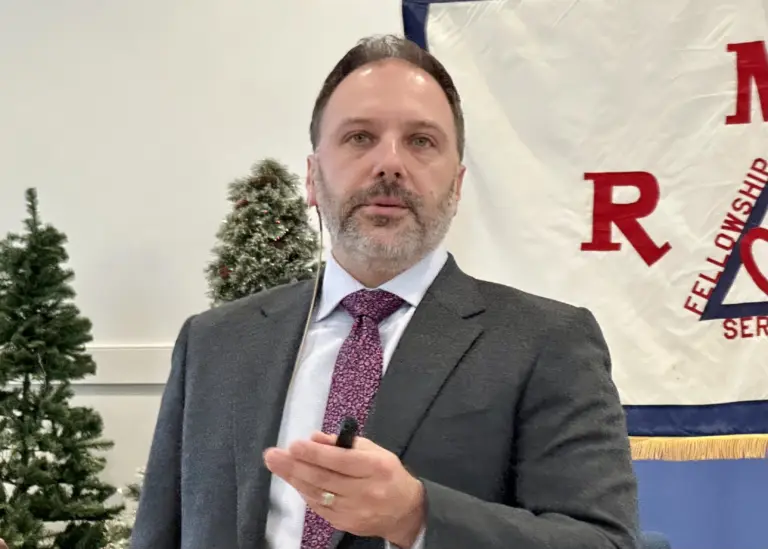RMA Presents “Will the Lights Go Out in New England? The Future of the Electric Grid – and Your Electric Bill”

By Arnold Gordon
On December 13, 2023 Program Committee Chairman Bob Meaney introduced State Senator Ryan Fazio, whose topic dealt with the difficult position of New England and Connecticut regarding electricity prices and supply. Senator Fazio was elected State Senator in August 2021, and he was re-elected in 2022. He represents Connecticut’s 36th District, which includes Greenwich, Stamford, and New Canaan. He grew up in Greenwich and attended public schools here. After studying economics at Northwestern University, he chose to return to Connecticut to live and work. Ryan is the Ranking Senator on the legislature’s Energy & Technology Committee and Planning and Development Committee. He also serves on the Transportation Committee and the Finance, Revenue and Bonding Committee.
He and his committee’s overall objective is to ensure that over the next 10 years and beyond, we are able to “keep the lights on,” prevent major price hikes, and protect the environment. As of now, the forecast for the next 20 years appears dim without substantive policy and infrastructure changes. There are worries of potential rolling blackouts or shortages if capacity is not adequately expanded. Connecticut ranks second in the continental U.S. for highest electricity costs to consumers; most of New England is above average. The high electricity costs in Connecticut hamper economic growth and disproportionately impact lower income residents. However, the shift to much more expensive renewables like offshore wind could sharply increase rates further, by Fazio’s estimate around $500-1000 more per household per year.
The source of power throughout New England today is as follows: natural gas 40%, nuclear 23%, imports (mostly hydropower from Canada) 14%, coal and oil 9%. As a result of conversion to natural gas from oil and coal over the past 15 years, heat trapping emissions have been reduced by 56%. However, while greenhouse gas emissions have fallen, Connecticut’s grid still relies heavily on fossil fuel plants for backup when renewables such as wind and solar cannot deliver. Germany’s experience in closing its nuclear power plants shows that heavy renewable investments do not reduce emissions without reliable clean alternatives such as nuclear energy. Although there are always concerns around nuclear plant safety and waste storage that can last for generations, new plant designs and waste management technologies add confidence toward their acceptance.
Demand for energy is expected to increase 70% by 2040 and there will be a conflict between home heating needs and the use of energy sources to generate electricity. Overall, New England probably has to double electricity generation over the next 20 years. Eversource estimates that $1.5 to $2.9 billion will be needed for substation upgrades.
Fazio promotes an “all-of-the-above” clean energy policy, treating sources like nuclear, hydro, solar and wind equally. While Connecticut has made some progress in lowering emissions, he paints a picture of an energy grid facing deeply worrying reliability, affordability, and even lingering environmental challenges without major policy changes. He believes substantial reforms are needed to bolster Connecticut’s energy system. As a result, he and a colleague have proposed a bipartisan bill that would include fair and equal treatment for hydro and nuclear along with wind and solar sources as part of all inclusive “Renewable Energy Portfolios.” This allows market competition while meeting environmental and reliability goals. Renewables like offshore wind are expected to provide much of the new capacity but face issues around weather-dependent intermittency and higher costs compared to traditional methods of generation. He also proposes to eliminate certain federal and local fees that are included in our electricity bills that have no relation to generation and transmission of energy to homes and businesses; he regards them as a form of taxation. Their elimination would reduce our bills by 10-12%. The talk was followed by a lengthy Q&A period.
To see the full presentation, go to https://greenwichrma.org, cursor to “Speakers” and click on “Speaker Videos.”
The RMA’s upcoming presentation, “Why Our Brains Need Wildlands,” by Susan Masino, Ph.D., is scheduled for 11 AM on Wednesday, January 3rd, 2024. Protecting our brains and protecting nature are both vitally important for our long-term wellbeing. Professor Susan A. Masino will share how these two goals are mutually reinforcing, and how common-sense actions can benefit individual and collective health. To stream the presentation by Dr. Masino at 11 AM on Wednesday, January 3rd, click on https://bit.ly/30IBj21. This presentation will also be available on local public access TV channels, Verizon FIOS channel 24 and Optimum (Cablevision) channel 79.
Note: The views expressed in these presentations are those of the speakers. They are not intended to represent the views of the RMA or its members.
RMA speaker presentations are presented as a community service at no cost to in-person or Zoom attendees, regardless of gender. Any member of the public who would like to receive a weekly email announcement of future speakers should send a request to members@greenwichrma.org. The RMA urges all eligible individuals to consider becoming a member of our great organization, and thereby enjoy all the available fellowship, volunteer, and community service opportunities which the RMA offers to its members. For further information, go to https://greenwichrma.org/, or contact members@greenwichrma.org.




